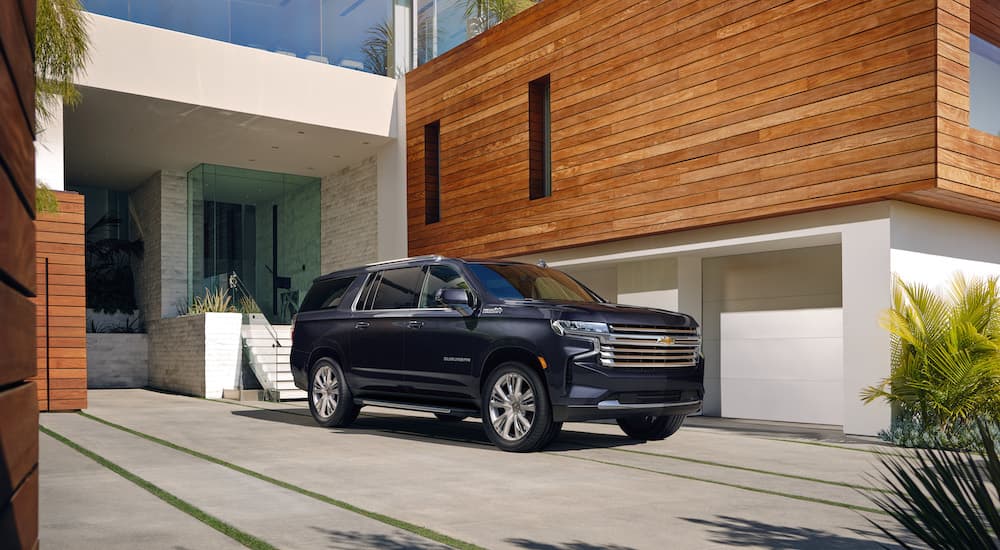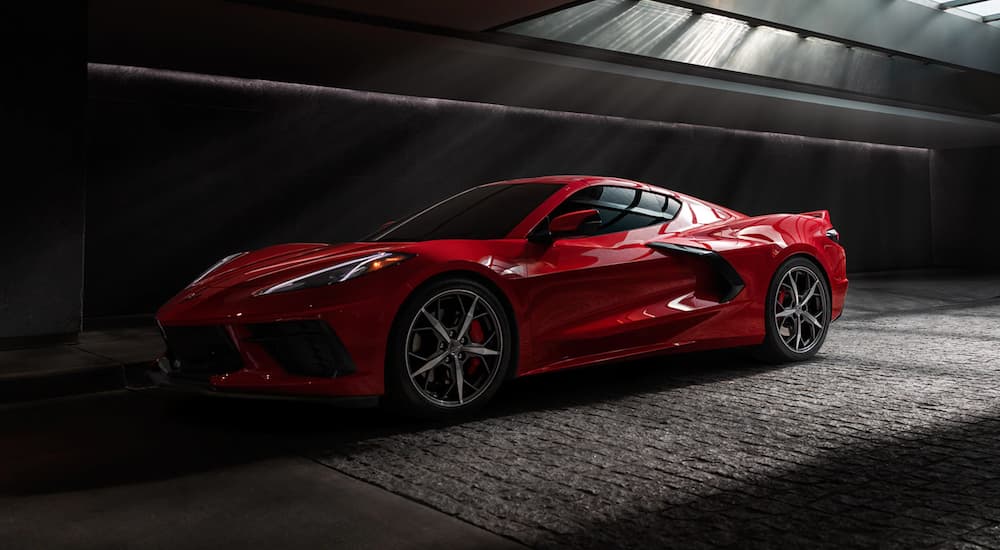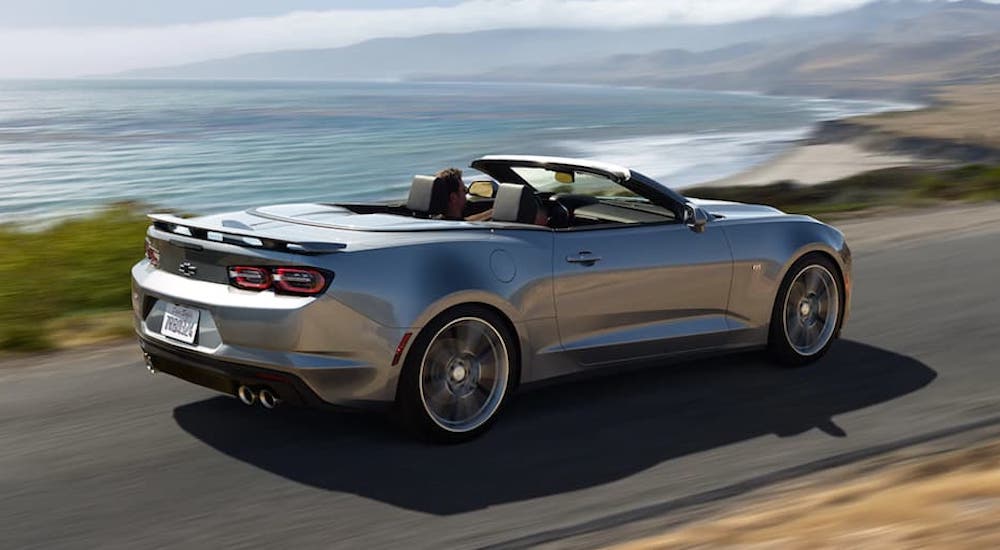- 2024 SILVERADO CREW CAB 1500 LTZ/HIGH COUNTRY- $9,750 OFF OR $12,000 WITH TRADE ASSISTANCE.
- Disclaimer: Dealer Discount $7000. GM Rebate $2750. Trade Rebate $2250 must trade 2010 or newer. Branded, scrap, or salvage title not acceptable. In stock units. Plus tax, title, license and fees. Offers expire on 4/30/24.
- Click here for Savings

One of the oldest automakers in the industry today is Chevrolet. Many people know about the automaker, and many Americans own a Chevy, whether it’s a sedan, a truck, an EV, or an SUV. The company has been going strong for over a century, which means they have some of the most recognized nameplates in the industry. Not only that, but it also means they have had some of the longest-running nameplates in the industry. Some of them are even still available, whether you’re buying a brand-new model or shopping for something from a used Chevrolet dealership.
So, just how old are some of the current nameplates, and what are some of the longest-running nameplates in the Chevy line-up? Well, it’s time to take a trip down memory lane and scour through some of the more popular and more long-lasting models that Chevy has rolled out over the years and just how long some of them have been on the market. You might even be surprised at just how persistent some nameplates have become in terms of maintaining their legacy for multiple generations and decades on end.
1. Chevy Suburban (In Production Since 1934)
While the Chevy Corvette is one of the more recognized names in the automotive industry, and the Chevy Bolt EV has been talked about quite a lot due to the upsurge in electric vehicles being introduced into the market, the actual longest-running nameplate in Chevy’s illustrious line-up that is still in production today is actually the Chevy Suburban. It originally made its debut on the market way back in 1935 after going into production in 1934. It was a very different-looking vehicle back then.
The Suburban was always a full-size vehicle but looked more like a five-door town car in its original incarnation. That’s because it was basically built as a station wagon on a truck chassis. It wasn’t until 30 years later, during the 1960s, that the more traditional SUV elements started popping up, and it wasn’t until the early 1980s that it started to resemble the shape and format that would eventually develop into what it is today. After twelve generations and 90 years of production, the Suburban has been finely crafted and honed into one of the most recognized, popular, and feature-rich SUVs on the market today.

2. Chevy Corvette (In Production Since 1953)
The Corvette is a staple not just in Chevy’s long-running automotive history but also in sports car history, performance vehicle history, and motorsports history. The Corvette is one of the longest-running nameplates in the automotive industry, alongside the Chevy Suburban, and with good reason. As a Chevy vehicle, it began production in 1953, where hundreds were hand-built by hardworking and dedicated individuals on the assembly room floor. Chevy’s first sports car and America’s longest-running production sports car nameplate was born.
The Corvette moseyed through the early and mid-1960s muscle car era modestly enough, but it was during the late 1960s and early 1970s, with the prominent showcase of the Stingray moniker, that it took the world by storm again. Exotically curvaceous lines and lots of power to boot made the Stingray a performance staple in the Corvette line-up, much like the Chevy SS moniker for select sports sedans and trucks. The Corvette is one of the rare sports cars from many bygone eras that are still in production to this very day, having sold over 1.75 million units since its debut on the market. With multiple redesigns, powertrain changes, and trim levels made available over its 71-year production history, it speaks volumes to the staying power of the Chevy Corvette nameplate.
3. Chevy Impala (Production Run 1958 – 2020)
The Chevy Impala is a well-recognized name when it comes to defining the post-Tri-Five days of Chevy’s burgeoning muscle car run. The Impala was actually introduced in 1958 as Bel-Air trim and then eventually branched off into its own nameplate later in 1958 during its second generation run. The flared fenders, tear-drop tail lights, and conspicuously gaudy rear fascia helped make the Impala fit right in with certain other Cadillac, Pontiac, and Oldsmobile models. However, as the competition and rebadged models faded over time, the Impala stayed.
As a nameplate, it’s one of the most radically changed offerings from Chevy since its debut in 1958. The 62-year production run spanned some fairly drastic alterations of the Impala, going from a luxury four-door town car to a two-door coupe to a four-door economy sedan. You can see how Chevy was desperately trying to find a place for the Impala through each of its ten generations, as it bounced back and forth between being a sleeper luxury sedan to an economy-class family sedan and a little bit of everything in between. It only recently came to an end with the 2020 model year, where it rounded its run as a luxury-economy full-size sedan.
4. Chevy Malibu (In Production Since 1964)
Probably one of Chevy’s most under-appreciated nameplates, the Chevy Malibu has been a stronghold and cornerstone of Chevy’s sedans for nearly half a century. The Chevy Malibu has been in production since 1964 and has consistently been adapted for the times over the course of nine generations. The Malibu actually had its start as more of a luxury town-car sedan as the top trim of the Chevy Chevelle. It was a two-door model available in coupe, convertible, or wagon format when it first appeared and was actually one of the early adopters of the Chevy SS performance package.
Over the years, the Malibu was made more distinctly its own, transforming into more of a sports-back muscle car during the 1970s before eventually evolving into a completely separate nameplate from the Chevelle during the fourth generation. It found itself fitting into more of a mid-tier sedan segment. It wasn’t until the 1990s that the more familiar design cues came about, and the economy-class feature set became standard for the four-door family vehicle, which matured into the current generation of the Malibu on the market today.
5. Chevy Camaro (In Production Since 1966)
The Chevy Camaro is almost as iconic as the Chevy Corvette. It’s considered the pony car alternative to the more high-performance and sports-centric ‘Vette. Both have shared many powertrain similarities over the years, but their styles couldn’t be more disparate. While the Corvette is low, sleek, and stylish, the Camaro has more of a classic muscle car appeal, being brawnier and more guttural with its performance intent. It makes sense, given that the Camaro arrived on the scene, starting its production in 1966 at the height of the muscle car craze.
The design of the Camaro always stood out and always looked cool. The late 1960s models had refined sports appeal, while the 1970s versions went in the opposite direction, going full-bore muscle car, especially with the souped-up Z28 Edition. The introduction of the IROC-Z during the 1980s kept the high-performance sports car appeal strong with the Camaro, but then that appeal began to fade during the 1990s, when it became just another pony car. The spark was revived with the fifth generation outing in 2010, sporting a modern take on the classic design that resonated well with fans and has continued to do so up to the most recent model year outings, giving the Camaro a good 58-year production run on the market.

6. Chevy C/K (Production Run: 1959 – 2002)
While a strong argument can be made for the Silverado having a longer run on the market than the Chevy C/K because it started as a trim for the C/K, the reality is that the Silverado didn’t really become its own nameplate until the late 1990s. The Chevy C/K series of pickup trucks, however, date all the way back to a production run that started in 1959. The two- or four-wheel drive pickups spanned both full and medium-duty consumer and commercial trucking models.
The Chevy C/K produced some highly popular vehicles over the course of its four generations on the market, with certain models like the C10, in particular, being a popular choice among trucking enthusiasts. The 43-year production run of the C/K line of trucks came to a weird closure, however, as it was being phased out as the Silverado and Colorado were coming into their own, and the GMC Sierra was beginning to gain its own independence as a nameplate with the introduction of the GMT800 platform. The C/K was unceremoniously renamed to the Silverado Classic, as it was phased out after the 2002 model year.
7. Chevy Monte Carlo (Production Run: 1969 – 2007)
The Chevy Monte Carlo is one of those poor vehicles that’s easy to forget in Chevy’s long line-up of different vehicles, much like how it’s easy to forget the short-lived Chevy SS nameplate that only managed a few years on the North American market before being pulled. However, unlike the Chevy SS nameplate, the Monte Carlo has been around for multiple generations and spans decades when it comes to its production run. It’s one of the more recent vehicles from a bygone era to have the plug pulled.
The Monte Carlo originally went into production in 1969 and was designed as a two-door, dinosaur-sized luxury performance coupe. It rocked a big V8 and had a rather refined look, given its role in the market. It leaned heavily into its performance sports appeal throughout the 1970s before eventually finding itself on a much smaller wheelbase and a much more compact design during its 1980s production run. It had a short-lived stint as a high-performance muscle car during the late 80s with the Monte Carlo SS and then faded away for a while before returning in the 1990s as an economy-class two-door coupe. Despite losing a lot of its performance appeal, it stayed relevant until 2007, when it was solemnly phased out.
8. Chevy Bel-Air (Production Run: 1949 – 1981)
The icon of the Tri-Five era, the face of a revolution, the legend that is the Chevy Bel-Air. It could easily be considered one of the absolute best cars ever made in terms of its design appeal and recognition. The Chevy Bel-Air represents the face of the enterprising era, moving from the large steel coffins of the 1940s into the more sleek and recognizable designs that greatly diversified the automotive industry throughout the 1950s. The Bel-Air was truly one of the more unique outings from the Chevy line-up that still resonates with car enthusiasts today.
In production from 1949 through 1954, the Bel-Air has had a very unique run on the market over the course of its five years. The unique design, performance scaling, and features helped keep it on the market for multiple generations, and it had a pretty good run over the course of three decades. It would be nice to see a re-imagined and modern take on the classic design for today’s market.
9. Chevy Blazer (Production Run: 1969 – 1994, 2018 – Current)
The Chevy Blazer is actually much older than some people might think. It originally had its production run back in 1969 as a way to rival the popular Ford Bronco. The more things change, the more they stay the same, as the Blazer and Bronco are both back on the market and completely redesigned for the modern driving market. The original Blazer, however, was a full-size SUV and really lived up to being a rugged utility vehicle. The original Blazer had a production run up to 1994.
The newer generation Blazer is a midsize crossover SUV that is also available as an EV. It’s a far cry from the original and rugged Blazer, with the new model focusing on a very performance-oriented and sporty look. While the production run hasn’t been consecutive, it has spanned the course of 55 years. However, the actual consecutive production years culminate to 31 years, which is still quite impressive for the Blazer nameplate.





